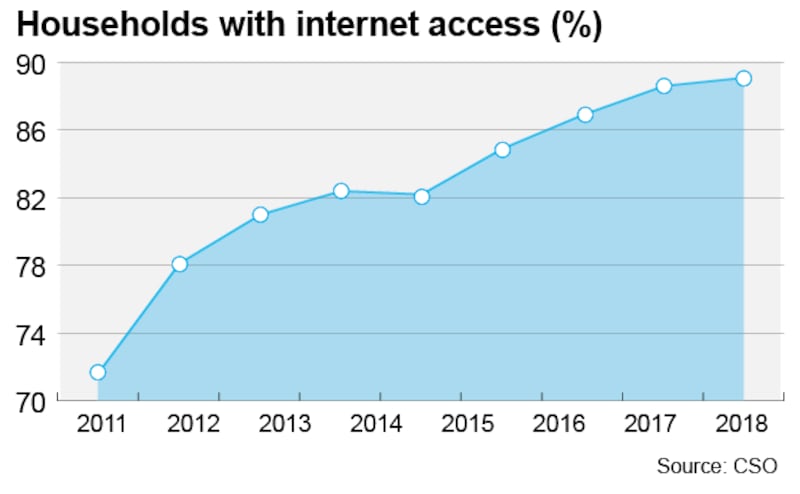Hundreds of thousands of Irish people have no access to the internet at home with many people believing they do not need it and others fearful they lack the skills to use it, new data has revealed.
Figures published by the Central Statistics Office (CSO) show that 11 per cent of the population do not have online access at home, with 40 per cent of that cohort saying they believe it unnecessary and 30 per cent expressing concern about the skills needed to use it
A further 8 per cent said they had access to the internet elsewhere while 6 per cent of those without broadband said it was because it was unavailable in their area. Other barriers included the high cost of equipment and charges imposed by service providers.
The proportion of people with access to the internet at home has remained steady at 89 per cent with the vast majority now using smartphones to go online, the research found.
The number of households with an internet connection is unchanged from 2017, a 17 per cent jump since 2010.
The figures point to an increasingly connected country with 82 per cent of those contacted saying they had used the internet in the three months prior to interview.
Digital divide
There is evidence of a digital divide caused by geographic, income and age factors. Fixed broadband connection is highest in the Dublin region on 90 per cent compared with the Border and Midlands regions where it is 69 per cent and 67 per cent respectively.

Fixed broadband connections are most commonly found in households described as being very affluent and its prevalence gradually decreases as the level of deprivation increases.
The percentage of individuals in the 16-29 and 30-44 year age groups who recently used the internet was twice the corresponding figure for persons aged 60-74 years – 97 per cent compared with 48 per cent respectively.
At 88 per cent, finding information on goods and services was the most common online activity with email in second place on 84 per cent. Reading or downloading online news and accessing social networks were tied for third place on 73 per cent.
The most common types of goods or services bought online were clothes, with one in two people saying they had made such purchases. Booking holiday accommodation and making other travel arrangements were cited by more than 40 per cent of users, while 49 per cent of those polled said they had stored files online.
Smartphone ownership
While 90 per cent of Irish people have a smartphone, the data indicates that fixed broadband is the most common type of internet access on 82 per cent compared with 52 per cent for mobile broadband.
Almost three-quarters of internet users used the internet every day, an increase of nine percentage points since 2014, with the frequency of internet use climbing for all age groups in 2018.
The Dublin region had the highest daily internet use on 84 per cent, up five percentage points on 2017. In the Border region, over two-thirds of internet users accessed the internet daily, an increase of 11 percentage points on the same period in 2017.
Respondents who used the internet daily were asked if they used the internet several times during the day with 68 per cent saying they did.
Two-thirds of people who shopped online in the previous 12 months did not experience any problems, although 18 per cent said speed of delivery was an issue.
The figures also show over one-third of people bought products online six or more times in the previous three months, an increase of eight percentage points on 2017.







